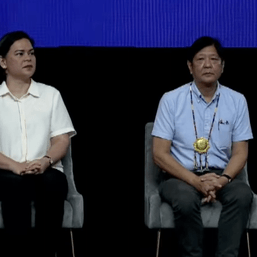SUMMARY
This is AI generated summarization, which may have errors. For context, always refer to the full article.
![[ANALYSIS] Are prices slowing down at last?](https://www.rappler.com/tachyon/2023/04/prices-slowing-down-april-11-2023.jpg)
The summer heat has been relentless, but are we at least getting respite from inflation?
On April 4, the Philippine Statistics Authority (PSA) reported that in March, inflation (or the pace of price increases) slowed down to 7.6%, a full one percentage point lower than in the previous month (Figure 1).
This is a sizable drop: inflation is now at its lowest since October 2022. This is also the second consecutive month of decline. If this trend continues, then inflation will have peaked at 8.7% in February 2023.
Figure 1.
Figure 2 also shows that for the first time since August 2022, the contribution of food to inflation dropped.
Figure 2.
The fact that food inflation has declined is relieving because it figures heavily in the everyday budget of a typical household. Notice that the contribution of vegetables decreased a lot, and so did meat (Figure 3). But sugar’s contribution dropped but only by a bit, and those of fish, milk, bread, and flour haven’t dropped.
Rice’s contribution also inched up. Even the Department of Agriculture admitted that rice prices will likely rise by P5/kg this year, moving away from the President’s campaign promise (more like an “aspiration”) of bringing down rice prices to P20/kg.
Figure 3.
As for utilities, electricity prices are also easing somewhat. But rent continues to rise, and water’s contribution has increased for the third consecutive month.
Meanwhile, there was a noticeable drop in the contribution of transportation inflation. For the first time since February 2021, the contribution of “operation of personal transport equipment” was negative. This means that it pushed down, rather than pulled up, transportation inflation, which is now almost exclusively accounted for by passenger transport services (pamasahe, basically).
Finally, the contribution of restaurant and hotel services to inflation has been increasing steadily since June 2022 owing to “revenge spending” or pent-up demand for bookings, now that the economy has more or less fully reopened. In other words, people are eating out and booking hotel rooms, and that’s stoking demand and prices.
Still not over
The decline of food inflation is especially important because the poor consume more than half of their budget on food. Figure 4 shows that other than “headline” inflation (the one commonly reported in the news), the inflation rate felt by the poorest 30% of households also dropped a lot.
Note, though, that despite gains in reducing inflation, both these measures of inflation are still much higher than the government’s 2%-4% target.
Lower inflation also doesn’t mean that prices are going down. Prices are still rising, but at a slower rate.
What’s more, “core” inflation, which excludes the prices of volatile items like food and energy prices, has inched up to 8% and is now higher than the headline rate of 7.6%. This is highly unusual. It points to the fact that inflation today is largely because of non-food and non-energy items like rent, transport fares, and restaurants – things whose prices have risen with the full reopening of the economy.
Figure 4.
The bottom line is that the Marcos government’s fight against inflation is far from over.
For instance, the Organization of Petroleum Exporting Countries (OPEC) recently announced a plan to cut production, and this has stoked oil prices already.
Meanwhile, because of rising core inflation – which worries economists more than headline inflation – the Bangko Sentral ng Pilipinas (BSP) might still decide to raise interest rates.
Just last March 23, the BSP announced that they hiked interest rates by 25 basis points (0.25 percentage point), citing the rise of core inflation in February.
They also forecast that inflation will continue to be elevated for the rest of 2023, owing to “the effect of supply shortages on domestic food prices” as well as “higher transport fares, increasing electricity rates, as well as above-average wage adjustments in 2023.”
Marcos’ plans
What exactly is President Ferdinand Marcos Jr. doing to fight inflation? Did he have anything to do with the drop in inflation last March?
In early March 2023 – nearly one full year since inflation started rising dramatically – the President created an “Inter-agency Committee on Inflation and Market Outlook.” Co-chaired by the finance and socioeconomic planning secretaries, this Inter-agency Committee will supposedly “serve as an advisory body to the President and the Cabinet on measures to mitigate inflation and ensure food and energy security.”
It will also supposedly provide the president “scientific, science-based forecasts” regarding the supply and demand for agricultural commodities, and offer advice on the timely importation of such things.
But this committee is redundant since the President is concurrently the head of the Department of Agriculture, which already knows the optimal timing of importing commodities year-round. The National Economic and Development Authority (NEDA) is also supposed to brief the President on all things inflation, with the PSA under its wing.
The timing of this committee’s creation is also off. The President already wrought damage by refusing to import commodities on time in 2022, leading to dramatic price spikes in sugar and onions. In other words, he should have come up with this committee last year – not when inflation already showed signs of peaking.
In addition, because of steadily rising core inflation, maybe this group should focus its attention less on food and energy and more on other items.
Finally, on a separate occasion, Finance Secretary Ben Diokno said that the Inter-Agency Committee might employ satellite technology to monitor agricultural production nationwide, and use the collected images and data to advise the President in the fight against inflation.
Sure, this is another tool in the fight against inflation. But the President already has at his disposal daily and monthly price data from the DA and PSA, apart from other regular reports about agricultural production.
More to the point, will satellite data prompt the President to act any faster against inflation – when it has taken him months to create this inter-agency committee? And will it make him do anything besides his preferred response so far, which is ordering the creation of more Kadiwa stores nationwide? – Rappler.com
JC Punongbayan, PhD is an assistant professor at the UP School of Economics and the author of False Nostalgia: The Marcos “Golden Age” Myths and How to Debunk Them. JC’s views are independent of his affiliations. Follow him on Twitter (@jcpunongbayan) and Usapang Econ Podcast.
Add a comment
How does this make you feel?









![[In This Economy] Marcos’ POGO ban is popular, but will it work?](https://www.rappler.com/tachyon/2024/07/thought-leaders-marcos-pogo-ban.jpg?resize=257%2C257&crop=255px%2C0px%2C720px%2C720px)
![[Rappler Investigates] POGOs no-go as Typhoon Carina exits](https://www.rappler.com/tachyon/2024/07/newsletter-graphics-carina-pogo.jpg?resize=257%2C257&crop=424px%2C0px%2C1080px%2C1080px)








![[In This Economy] Part 2 | POGOnomics: Are we banning POGOs out of fear, outrage, not rational thought?](https://www.rappler.com/tachyon/2024/06/thought-leaders-pogonomics-part-2b.jpg?resize=257%2C257&crop=292px%2C0px%2C720px%2C720px)
![[In This Economy] POGOnomics: Weighing the costs and benefits of POGOs](https://www.rappler.com/tachyon/2024/06/thought-leaders-pogonomics-part-1.jpg?resize=257%2C257&crop=279px%2C0px%2C720px%2C720px)
![[In This Economy] Is the Philippine economy stable?](https://www.rappler.com/tachyon/2024/05/philippine-economy-stable-may-10-2024.jpg?resize=257%2C257&crop=461px%2C0px%2C1080px%2C1080px)

There are no comments yet. Add your comment to start the conversation.